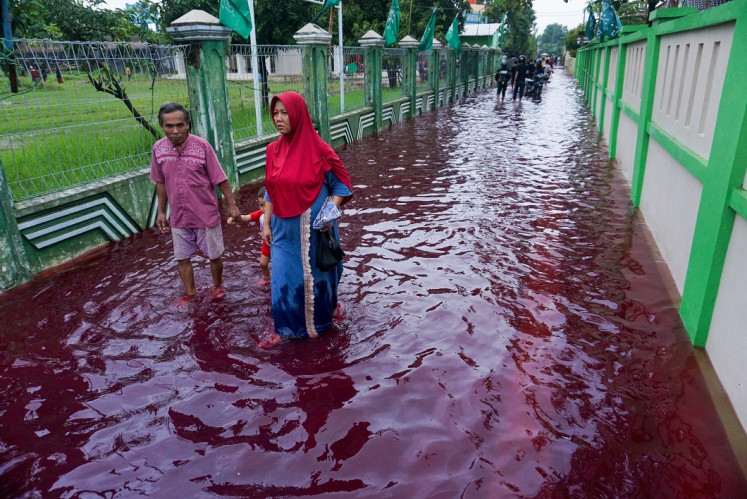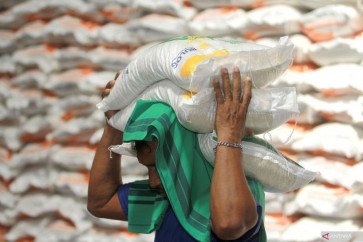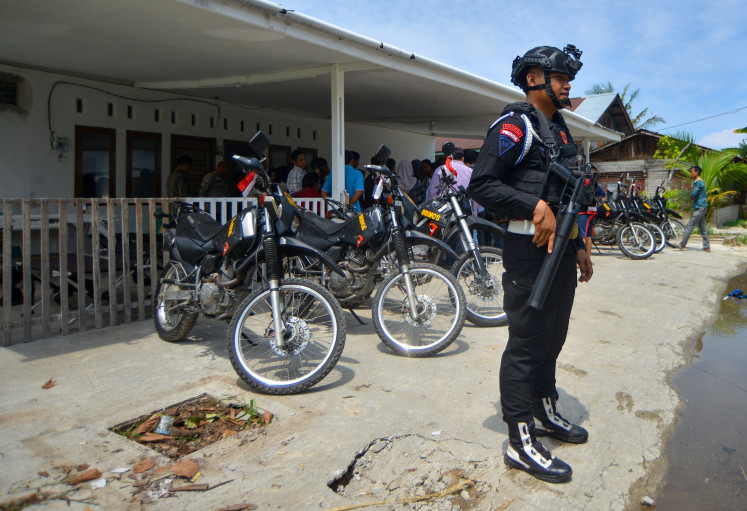Popular Reads
Top Results
Can't find what you're looking for?
View all search resultsPopular Reads
Top Results
Can't find what you're looking for?
View all search resultsFloods hit several Indonesian cities as rainy season nears peak
The Meteorology, Climatology and Geophysics Agency has issued flood warnings for five Java provinces.
Change text size
Gift Premium Articles
to Anyone
W
ith the peak of the rainy season just around the corner, a number of areas in Indonesia have been inundated following heavy downpour over the past few days.
The Meteorology, Climatology and Geophysics Agency (BMKG) issued flood warnings on Tuesday for four of Java’s six provinces -- Banten, West Java, Central Java and East Java -- effective until Thursday. The provinces have been put on siaga (watch) status, the second-highest level of the country's four-tiered alert system. Jakarta and Yogyakarta remain at the third-highest status, waspada (advisory).
“According to the forecast from climatologists, February is the peak of the rainy season for Java Island,” BMKG weather forecaster Nanda Alfuadi said as quoted by kompas.com.
Jakartans are advised to brace for floods as the Katulampa Dam in Bogor, West Java, saw its water level rise to 120 centimeters since Sunday morning. Indonesia's capital and its surrounding areas -- especially the Puncak area and Bogor -- have seen torrential rain since last week. People living near the Ciliwung River are advised to be vigilant in light of potential flooding.
Read also: Indonesia braces for more weather disasters. Climate crisis will make them worse
Jakarta Water Agency secretary Dudi Gardesi said the city had allocated more funds for flood control this year at about Rp 3 trillion (US$214 million), up from Rp 2.5 trillion last year, when the COVID-19 pandemic forced the city to delay the construction of some projects related to flood mitigation.
"We received less funding last year as the economy contracted due to COVID-19 pandemic," Dudi told The Jakarta Post recently. "Most of the budget this year will be used to finish the programs that were delayed last year, such as land procurement for river restoration and projects to build more water pump stations and reservoirs."
The Jakarta Water Agency has recently built three pump stations, adding to a total of 487 pumps already installed in 178 locations across the city. It is planning to build five more pumps this year, as well as reservoirs and infiltration wells to mitigate floods, one of the capital’s annual problems.
In Central Java, floods hit Semarang city on Saturday after massive downpour battered the city overnight, according to BMKG in a press release. Floodwater inundated two main rail hubs, namely Tawang Station and Poncol Station, on Saturday and Sunday, disrupting train services connecting Semarang with other cities, such as Jakarta, Surabaya and Tegal.
“Tawang and Poncol stations, as well as Batang lane up to Semarang are inundated,” Krisbiyantoro, public relations manager of PT Kereta Api Indonesia’s (KAI) Semarang office, said as quoted by kompas.com on Saturday.
He said 70-cm-high water flooded Tawang Station up to the street in front of the station.
Services of at least five freight trains were also affected by flooding in Semarang.
Meanwhile, photos of blood-red floodwater are spiraling on the internet after Jenggot subdistrict in the batik production town Pekalongan, also in Central Java, was hit by flood. Reports said the floodwater was mixed with spilled red coloring chemicals from a batik factory.
Residents wade through floodwaters dyed red from the waste of a batik factory, a traditional textile product, in Pekalongan, Central Java on Feb. 6. (AFP/Shaka)Officials later said the unique color came from harmless fabric dye used by several batik factories in the area, AFP reported.
The BMKG also warned on Saturday about potential heavy rain in some other provinces outside Java, for example, Aceh, Bengkulu and Bali, as well as some areas in Sulawesi and Kalimantan.
Read also: Displaced people in disaster-hit areas unprotected from pandemic
In West Kalimantan, a number of districts in Bengkayang regency were inundated on Thursday following heavy overnight rain, disrupting the main access to the Malaysian border. By Sunday, the floodwater had started to recede.
The BMKG said last week that the La Niña weather phenomenon could increase rainfall in Indonesia until at least April.
Last month, extreme weather caused at least three major hydrometeorological disasters in the country: a series of landslides in West Java’s Sumedang, widespread flooding in all but two regencies of South Kalimantan, as well as flooding and extreme waves in North Sulawesi. (syk)











